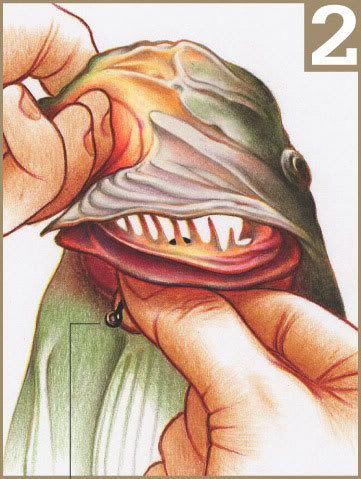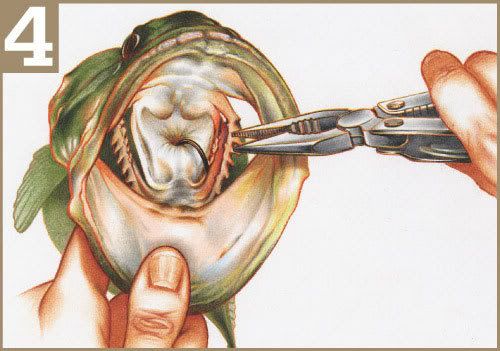Post by stinkiesdaddy on Feb 14, 2010 13:59:07 GMT -6
Doug Stange gave me permission to use this technique from his magizine InFisherman with the credit going to Ralph Manns the author
the technique is akin to some of the instruction we offered in an article by Ralph Manns (and In-Fisherman) in February 2002, "The Deep Hook Dilemma."
(1) With the hook in the gullet, note which side of the fish's mouth the hook shank is toward. Note: For illustration sake, the line is eliminated here in steps 2 through 5. In reality, the line stays connected as this technique is performed.

(2) With a finger or two, reach in through the last gill arch on that side of the fish and push and pull down on the hookeye so the hook turns and . . .

(3) rolls out below the gill toward the side of the fish. At that point, amazingly, the hook, barb and all, almost always pops free from its hold in the fish's gullet.

(4) Reach into the fish's mouth and grip the bend in the hook (which is now up) and . . .

(5) lift it free. If the fish's mouth is too small to reach in with your hand, use a needle-nose pliers to grip the hook bend.

Jackson also emphasized, as we also noted in the earlier article, how resilient a fish's gills actually are, far from being the fragile organs often suggest by some sources. And the occasional bleeding fish? Does it have to be kept? Jackson: "Just get the fish back into the water as soon as possible and, more often than not, the bleeding stops--at least we've caught these fish again and again.
The technique also works superbly on walleyes, smallmouths, and other fish, usually taken on smaller hooks, often salmon-style hooks. In a sidebar entitled "Hook Removal Walleye Style" in the February article, we related Mike Herrick's experiences in removing hooks by working through the gills, in much the same way Jackson works on largemouth bass.
the technique is akin to some of the instruction we offered in an article by Ralph Manns (and In-Fisherman) in February 2002, "The Deep Hook Dilemma."
(1) With the hook in the gullet, note which side of the fish's mouth the hook shank is toward. Note: For illustration sake, the line is eliminated here in steps 2 through 5. In reality, the line stays connected as this technique is performed.

(2) With a finger or two, reach in through the last gill arch on that side of the fish and push and pull down on the hookeye so the hook turns and . . .

(3) rolls out below the gill toward the side of the fish. At that point, amazingly, the hook, barb and all, almost always pops free from its hold in the fish's gullet.

(4) Reach into the fish's mouth and grip the bend in the hook (which is now up) and . . .

(5) lift it free. If the fish's mouth is too small to reach in with your hand, use a needle-nose pliers to grip the hook bend.

Jackson also emphasized, as we also noted in the earlier article, how resilient a fish's gills actually are, far from being the fragile organs often suggest by some sources. And the occasional bleeding fish? Does it have to be kept? Jackson: "Just get the fish back into the water as soon as possible and, more often than not, the bleeding stops--at least we've caught these fish again and again.
The technique also works superbly on walleyes, smallmouths, and other fish, usually taken on smaller hooks, often salmon-style hooks. In a sidebar entitled "Hook Removal Walleye Style" in the February article, we related Mike Herrick's experiences in removing hooks by working through the gills, in much the same way Jackson works on largemouth bass.





